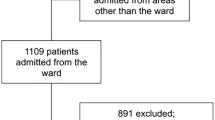Abstract
Objective
To determine the incidence of body temperature (BT) alterations in critically ill patients, and their relationship with infection and outcome.
Design
Prospective, observational study.
Setting
Thirty-one bed, medico-surgical department of intensive care.
Patients
Adult patients admitted consecutively to the ICU for at least 24 h, during 6 summer months.
Interventions
None.
Results
Fever (BT≥38.3°C) occurred in 139 (28.2%) patients and hypothermia (BT≤36°C) in 45 (9.1%) patients, at some time during the ICU stay. Fever was present in 52 of 100 (52.0%) infected patients without septic shock, and in 24 of 38 (63.2%) patients with septic shock. Hypothermia occurred in 5 of 100 (5.0%) infected patients without septic shock and in 5 of 38 (13.1%) patients with septic shock. Patients with hypothermia and fever had higher Sequential Organ Failure Assessment (SOFA) scores on admission (6.3±3.7 and 6.4±3.3 vs 4.6±3.2; p<0.01), maximum SOFA scores during ICU stay (7.6±5.2 and 8.2±4.7 vs 5.4±3.8; p<0.01) and mortality rates (33.3 and 35.3% vs 10.3%; p<0.01). The length of stay (LOS) was longer in febrile patients than in hypothermic and normothermic (36°C<BT<38.3°C) patients [median 6 (1–57) vs 5 (2–28) and 3 (1–33) days, p=0.02 and p=0.01, respectively). Among the septic patients hypothermic patients were older than febrile patients (69±9 vs 54±7 years, p=0.01). Patients with septic shock had a higher mortality if they were hypothermic than if they were febrile (80 vs 50%, p<0.01).
Conclusions
Both hypothermia and fever are associated with increased morbidity and mortality rates. Patients with hypothermia have a worse prognosis than those with fever.

Similar content being viewed by others
References
Kramer MR, Vandijk J, Rosin AJ (1989) Mortality in elderly patients with thermoregulatory failure. Arch Intern Med 149:1521–1523
Reuler JB (1978) Hypothermia: pathophysiology, clinical settings, and management. Ann Intern Med 89:519–527
Circiumaru B, Baldock G, Cohen J (1999) A prospective study of fever in the intensive care unit. Intensive Care Med 25:668–673
Bryant RE, Hood AF, Hood CE, Koenig MG (1971) Factors affecting mortality of gram-negative rod bacteremia. Arch Intern Med 127:120–128
Hodgin UG, Sanford JP (1965) Gram-negative rod bacteremia. An analysis of 100 patients. Am J Med 39:952–960
Kreger BE, Craven DE, McCabe WR (1980) Gram-negative bacteremia. IV. Re-evaluation of clinical features and treatment in 612 patients. Am J Med 68:344–355
Clemmer TP, Fisher CJ, Bone RC, Slotman GJ, Metz GA, Thomas FO (1992) Hypothermia in the sepsis syndrome and clinical outcome. Crit Care Med 20:1395–1401
Arons MM, Wheeler AP, Bernard GR, Christman BW, Russell JA, Schein R, Summer WR, Steinberg KP, Fulkerson W, Wright P, Dupont WD, Swindell BB (1999) Effects of ibuprofen on the physiology and survival of hypothermic sepsis. Ibuprofen in Sepsis Study Group. Crit Care Med 27:699–707
Knaus WA, Draper EA, Wagner DP, Zimmerman JE (1985) APACHE II: a severity of disease classification system. Crit Care Med 13:818–829
Vincent JL, Moreno R, Takala J, Willatts S, de Mendonça A, Bruining H, Reinhart CK, Suter PM, Thijs LG (1996) The SOFA (Sepsis-related Organ Failure Assessment) score to describe organ dysfunction/failure. Intensive Care Med 22:707–710
Garner JS, Jarvis WR, Emori TG, Horan TC, Hughes JM (1988) CDC definitions for nosocomial infections, 1988. Am J Infect Control 16:128–140
ACCP-SCCM Consensus Conference (1992) Definitions of sepsis and multiple organ failure and guidelines for the use of innovative therapies in sepsis. Crit Care Med 20:864–874
McGowan JE, Jr., Rose RC, Jacobs NF, Schaberg DR, Haley RW (1987) Fever in hospitalized patients. With special reference to the medical service. Am J Med 82:580–586
Filice GA, Weiler MD, Hughes RA, Gerding DN (1989) Nosocomial febrile illnesses in patients on an internal medicine service. Arch Intern Med 149:319–324
Commichau C, Scarmeas N, Mayer SA (2003) Risk factors for fever in the neurologic intensive care unit. Neurology 60:837–841
Georgilis K, Plomaritoglou A, Dafni U, Bassiakos Y, Vemmos K (1999) Aetiology of fever in patients with acute stroke. J Intern Med 246:203–209
Doherty NE, Fung P, Lefkowitz M, Ellrodt AG (1985) Hypothermia and sepsis. Ann Intern Med 103:308
Megarbane B, Axler O, Chary I, Pompier R, Brivet FG (2000) Hypothermia with indoor occurrence is associated with a worse outcome. Intensive Care Med 26:1843–1849
Author information
Authors and Affiliations
Corresponding author
Rights and permissions
About this article
Cite this article
Peres Bota, D., Lopes Ferreira, F., Mélot, C. et al. Body temperature alterations in the critically ill. Intensive Care Med 30, 811–816 (2004). https://doi.org/10.1007/s00134-004-2166-z
Received:
Accepted:
Published:
Issue Date:
DOI: https://doi.org/10.1007/s00134-004-2166-z




